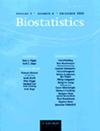Pooling controls from nested case–control studies with the proportional risks model
IF 2
3区 数学
Q3 MATHEMATICAL & COMPUTATIONAL BIOLOGY
引用次数: 0
Abstract
The standard approach to regression modeling for cause-specific hazards with prospective competing risks data specifies separate models for each failure type. An alternative proposed by Lunn and McNeil (1995) assumes the cause-specific hazards are proportional across causes. This may be more efficient than the standard approach, and allows the comparison of covariate effects across causes. In this paper, we extend Lunn and McNeil (1995) to nested case–control studies, accommodating scenarios with additional matching and non-proportionality. We also consider the case where data for different causes are obtained from different studies conducted in the same cohort. It is demonstrated that while only modest gains in efficiency are possible in full cohort analyses, substantial gains may be attained in nested case–control analyses for failure types that are relatively rare. Extensive simulation studies are conducted and real data analyses are provided using the Prostate, Lung, Colorectal, and Ovarian Cancer Screening Trial (PLCO) study.利用比例风险模型汇集嵌套病例对照研究的对照结果
利用前瞻性竞争风险数据对特定原因危害进行回归建模的标准方法是为每种故障类型建立单独的模型。Lunn 和 McNeil(1995 年)提出了另一种方法,即假设不同原因的特异性危害成正比。这可能比标准方法更有效,而且可以比较不同原因的协变量效应。在本文中,我们将 Lunn 和 McNeil(1995 年)扩展到嵌套病例对照研究,以适应额外匹配和非比例性的情况。我们还考虑了不同病因的数据来自对同一队列进行的不同研究的情况。结果表明,虽然全队列分析的效率仅能略微提高,但对于相对罕见的故障类型,嵌套病例对照分析的效率可大幅提高。我们利用前列腺癌、肺癌、结肠直肠癌和卵巢癌筛查试验(PLCO)研究进行了广泛的模拟研究,并提供了真实数据分析。
本文章由计算机程序翻译,如有差异,请以英文原文为准。
求助全文
约1分钟内获得全文
求助全文
来源期刊

Biostatistics
生物-数学与计算生物学
CiteScore
5.10
自引率
4.80%
发文量
45
审稿时长
6-12 weeks
期刊介绍:
Among the important scientific developments of the 20th century is the explosive growth in statistical reasoning and methods for application to studies of human health. Examples include developments in likelihood methods for inference, epidemiologic statistics, clinical trials, survival analysis, and statistical genetics. Substantive problems in public health and biomedical research have fueled the development of statistical methods, which in turn have improved our ability to draw valid inferences from data. The objective of Biostatistics is to advance statistical science and its application to problems of human health and disease, with the ultimate goal of advancing the public''s health.
 求助内容:
求助内容: 应助结果提醒方式:
应助结果提醒方式:


